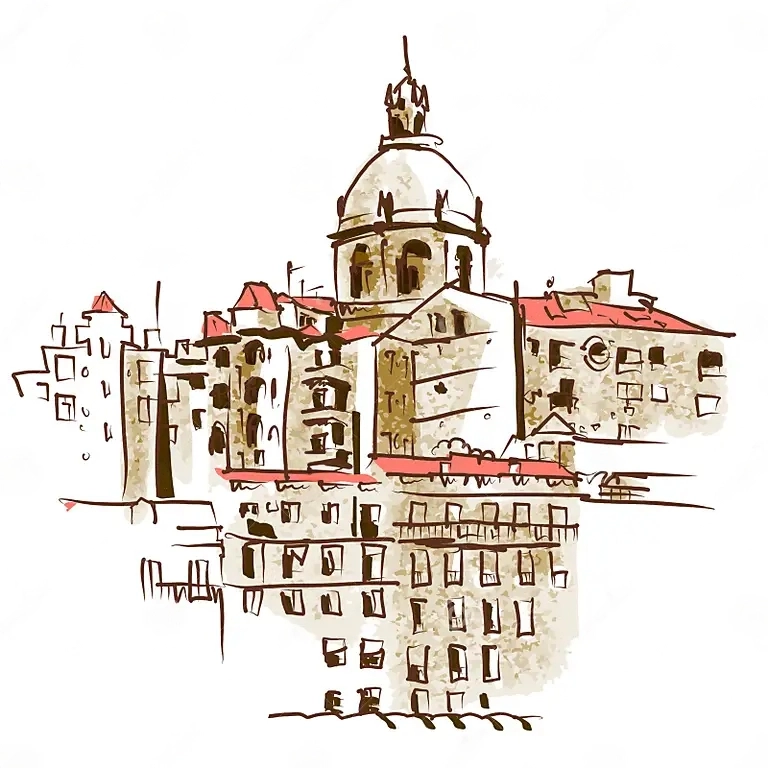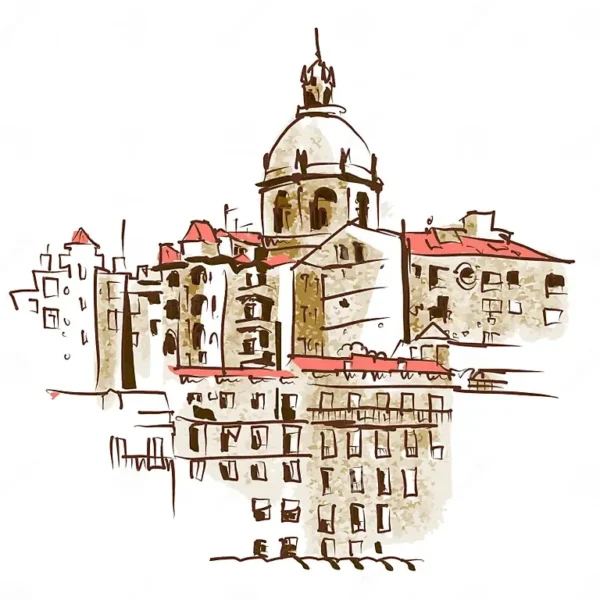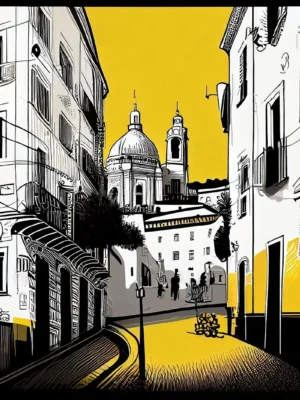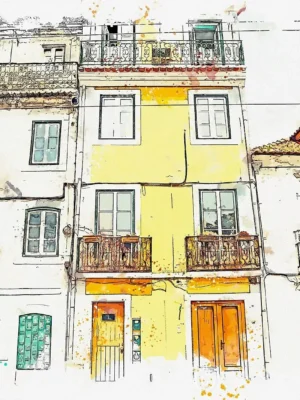€1.50
This artwork portrays an ancient urban landscape of Lisbon, Portugal, in a hand-drawn sketch style, featuring the iconic dome of the National Pantheon, set against a white background.
Lisbon’s Iconic National Pantheon: A Sketch of History and Heritage
When we think of Lisbon, Portugal, a vibrant city with a rich cultural heritage comes to mind. This enchanting European capital boasts a fascinating blend of history and modernity. One iconic symbol of Lisbon’s historical grandeur is the National Pantheon, which is elegantly captured in a hand-drawn sketch style artwork.
The Artwork: A Glimpse into the Past
This mesmerizing illustration takes us on a journey back in time, showcasing an ancient urban landscape of Lisbon. The city’s charming architecture and cobbled streets are beautifully depicted in a meticulous hand-drawn sketch. However, what truly steals the spotlight is the prominent presence of the National Pantheon’s dome.
The National Pantheon: A Symbol of Lisbon’s Heritage
The National Pantheon, or “Panteão Nacional” in Portuguese, is a monument of great historical significance. It’s a place where history, art, and culture converge. Originally a church dedicated to Santa Engrácia, it underwent a transformation over the centuries, eventually becoming the pantheon we see today.
Construction of the Pantheon began in the late 17th century, under the direction of architect João Antunes. However, the project took several decades to complete, and the structure remained unfinished for many years. It wasn’t until the 20th century that the Pantheon was finally completed, making it one of Lisbon’s architectural marvels.
Notable Figures at Rest
The National Pantheon serves as the final resting place for some of Portugal’s most illustrious figures. Here, you can find the tombs of famous Portuguese writers, poets, and national heroes. One of the most revered figures buried within its walls is Luís de Camões, Portugal’s national poet and author of the epic poem “Os Lusíadas.”
The Pantheon is also the eternal home of Amália Rodrigues, the “Queen of Fado,” whose soulful voice resonated with people worldwide and played a significant role in popularizing Fado music, Portugal’s traditional genre.
Visiting the National Pantheon
Today, the National Pantheon is open to the public, allowing visitors to explore its historic significance and architectural beauty. Inside, you’ll find stunning marble interiors adorned with intricate artwork and the tombs of Portugal’s most celebrated individuals.
The dome of the Pantheon, which dominates the Lisbon skyline, is an architectural masterpiece in itself. Its iconic silhouette adds to the charm of the cityscape and serves as a constant reminder of Lisbon’s rich history.
Preserving Lisbon’s Legacy
The hand-drawn sketch artwork that highlights the National Pantheon serves as more than just a beautiful image; it’s a tribute to Lisbon’s enduring heritage. Lisbon, with its blend of old-world charm and modern vitality, continues to captivate the hearts of travelers from around the world.
In conclusion, the National Pantheon of Lisbon is more than just a monument; it’s a symbol of Portugal’s history, culture, and artistic legacy. The hand-drawn sketch, with its meticulous attention to detail, pays homage to this iconic structure, inviting us to appreciate the grandeur and significance of Lisbon’s past and present. Whether you’re a history enthusiast, an art lover, or a traveler seeking cultural experiences, Lisbon’s National Pantheon is a must-visit destination that beautifully encapsulates the essence of this enchanting city.
Lisbon’s Iconic National Pantheon: A Sketch of History and Heritage
Preserving Lisbon’s Legacy
The hand-drawn sketch artwork that highlights the National Pantheon serves as more than just a beautiful image; it’s a tribute to Lisbon’s enduring heritage. Lisbon, with its blend of old-world charm and modern vitality, continues to captivate the hearts of travelers from around the world.
In conclusion, the National Pantheon of Lisbon is more than just a monument; it’s a symbol of Portugal’s history, culture, and artistic legacy. The hand-drawn sketch, with its meticulous attention to detail, pays homage to this iconic structure, inviting us to appreciate the grandeur and significance of Lisbon’s past and present. Whether you’re a history enthusiast, an art lover, or a traveler seeking cultural experiences, Lisbon’s National Pantheon is a must-visit destination that beautifully encapsulates the essence of this enchanting city.
A City of Contrasts
Lisbon is a city of striking contrasts. As you explore its narrow alleyways and hilly neighborhoods, you’ll encounter a delightful mix of architectural styles. From Moorish influences in the Alfama district to the grandeur of the Belém Tower, Lisbon’s architecture tells a story of its diverse history.
The National Pantheon, with its neoclassical design and commanding dome, stands as a testament to the city’s architectural diversity. Its gleaming white exterior gleams in the Portuguese sun, contrasting beautifully with the deep blue sky.
A Journey Through Time
Visiting the National Pantheon is like stepping back in time. The interior is adorned with stunning marble sculptures and intricate artwork that narrate Portugal’s history. As you walk through the hallowed halls, you’ll encounter the final resting places of Portugal’s most esteemed citizens.
It’s not just the illustrious figures entombed here that make the Pantheon special; it’s also the panoramic views of Lisbon that can be enjoyed from the dome. Ascending the spiral staircase to the top, visitors are rewarded with breathtaking vistas of the city, including the Tagus River and São Jorge Castle.
A Cultural Hub
Lisbon is not just a city of historical significance; it’s also a thriving cultural hub. The streets come alive with the sound of Fado music, a genre deeply rooted in Portuguese culture. The hauntingly beautiful melodies and soulful lyrics of Fado can be experienced in intimate local restaurants and large concert halls alike.
The National Pantheon pays homage to this cultural legacy, housing the tomb of Amália Rodrigues, the iconic Fado singer who left an indelible mark on the genre. Her influence on Fado music and her role in bringing it to the world stage are commemorated here.
Conclusion
In summary, the artwork capturing Lisbon’s National Pantheon encapsulates the essence of a city that seamlessly blends its rich historical past with a vibrant present. It serves as a reminder of the enduring legacy of Portugal and Lisbon’s place in the annals of history.
From its historical significance as a final resting place for national heroes to its architectural grandeur, the National Pantheon embodies the spirit of Lisbon. The hand-drawn sketch invites us to appreciate the city’s timeless charm and cultural treasures. Whether you’re planning a trip to Lisbon or simply seeking to immerse yourself in its history and heritage, the National Pantheon is an essential stop on your journey through this enchanting European capital.
Lisbon’s Iconic National Pantheon: A Sketch of History and Heritage (Continued)
A Culmination of Art and Architecture
The National Pantheon stands as a prime example of the harmonious marriage between art and architecture. Its dome, which dominates the cityscape, is a remarkable feat of engineering and design. The artwork captures the elegant lines and intricate details of this architectural masterpiece, highlighting the balance between form and function.
The Pantheon’s interior is equally awe-inspiring. Ornate chapels, marble columns, and beautifully crafted tombs create a sense of reverence and artistry. It’s not just a place for honoring the past; it’s a place where history itself is artfully preserved.
A Living History Lesson
As you explore the National Pantheon, you’ll find that it’s not just a static monument but a living history lesson. The various tombs and memorials offer insights into Portugal’s contributions to literature, music, politics, and more. From the great poet Luís de Camões to the renowned explorer Vasco da Gama, the Pantheon’s inhabitants are a testament to Portugal’s enduring impact on the world.
Visiting the Pantheon is like turning the pages of a history book, with each tomb representing a chapter in Portugal’s story. It’s a place where you can gain a deeper understanding of the nation’s cultural identity and historical significance.
The Pantheon in Modern Times
While the National Pantheon is a historical treasure, it continues to play a role in contemporary Portuguese life. It hosts cultural events, exhibitions, and concerts, celebrating the country’s artistic and intellectual achievements. The Pantheon serves as a reminder that history is not something relegated to the past; it’s a living, evolving narrative that shapes the present and future.
A Final Word
In the world of travel and exploration, there are places that captivate not just with their beauty but also with the stories they hold. Lisbon’s National Pantheon is one such place. The hand-drawn sketch that captures this iconic monument is more than just an image; it’s a gateway to a world of history, culture, and artistry.
As you admire this artwork, let it transport you to the charming streets of Lisbon, where centuries of history come alive in the architecture and culture. Let it inspire you to explore this city, to wander its historic neighborhoods, and to discover the treasures that await around every corner.
In Lisbon, the past and present coexist harmoniously, and the National Pantheon stands as a testament to this enduring spirit. It’s a place where history whispers in every shadowed corner and where the echoes of Portugal’s past continue to resonate in the present. Whether you’re an art enthusiast, a history buff, or simply a traveler seeking inspiration, Lisbon’s National Pantheon is a timeless destination that invites you to connect with the heart and soul of this remarkable city.







Reviews
There are no reviews yet.